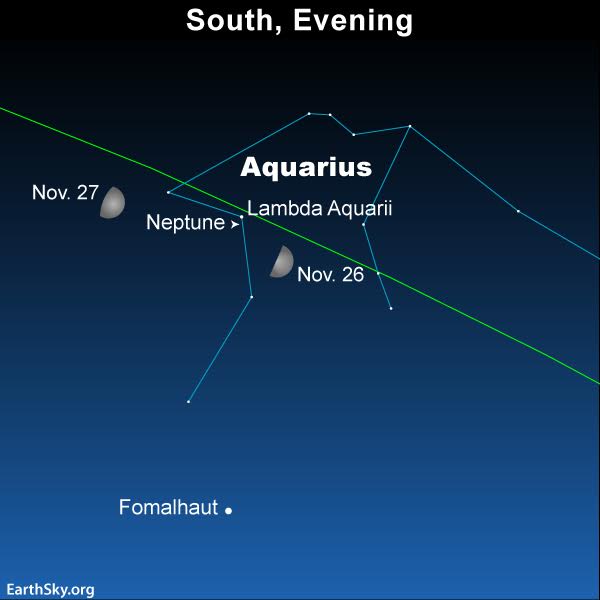
Tonight and tomorrow night – November 26 and 27, 2017 – the moon is sweeping near the 8th planet Neptune on the sky’s dome. It’s even harder than usual right now to find Neptune because of the moon’s glare. Still, if you want to know Neptune’s location on the sky’s dome – maybe in order to find it when the moon has moved away – look at tonight’s moon. It is pointing the way.
What will you see? Only the moon shining in all its splendor. You can gaze at it and imagine Neptune nearby.
The image below is a spacecraft image of Neptune. It’s from Voyager 2, the only spacecraft that has ever visited Neptune. The spacecraft’s closest approach to the planet occurred on August 25, 1989. Neptune is the eighth planet out from our sun and outermost of the major planets.
It’s the only major planet in our solar system that you absolutely can’t see with the unaided eye.

Like the moon, Neptune is close to the ecliptic, or path the planets follow in front of the constellations of the zodiac. We see them travel on or near this great circle on the celestial sphere because the major planets in our solar system orbit the sun on almost the same plane that Earth orbits the sun (or that the moon orbits Earth).
Although the moon and Neptune are close together on the sky’s dome tonight, they’re nowhere close in space. The moon resides just over one light-second from Earth, whereas Neptune looms way out there at over four light-hours away. In other words, Neptune is over 11,000 times farther away than the moon in tonight’s sky.
Once the moon leaves the evening sky, starting the second week of December, Aquarius will easy to spot in a dark country sky. Then, if you’re armed with a telescope or powerful binoculars and a good sky chart, you might be able to glimpse Neptune.
Neptune moves around the sun slowly in contrast to Earth. It takes 165 Earth-years to travel around the sun once, and thus it takes 165 years to travel completely around our sky. That means that Neptune has been hanging out more or less in the same location in our sky – in front of the constellation Aquarius, and near the star Lambda Aquarii – for a few years.

For a stellar reference, learn how to star-hop to Lambda Aquarii, your guide star to Neptune. Neptune demands high-quality binoculars or a telescope, patience and a detailed star chart. Look for Neptune and the star Lambda Aquarii to take stage within the same binocular field.
Bottom line: On November 26, 2017, use your mind’s eye to envision the solar system’s most distant major planet – Neptune – near the moon.
Do you love stargazing? Order your EarthSky Planisphere today!











